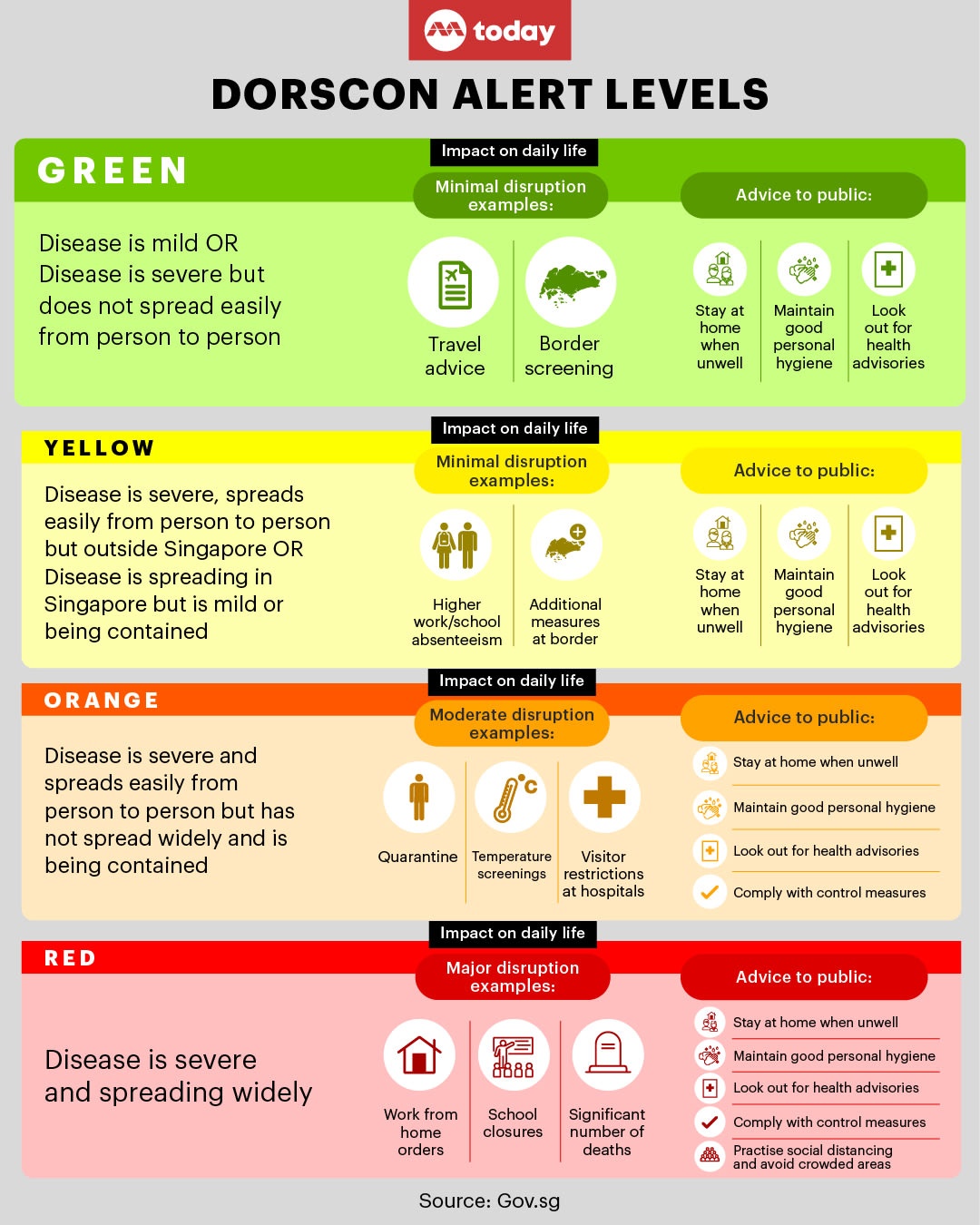Dorscon status to lower from yellow to green on Feb 13, Covid-19 task force to stand down: MOH
SINGAPORE — With the Covid-19 situation stabilising and causing minimal disruption to healthcare capacity and daily life, Singapore will lower the Disease Outbreak Response System Condition (Dorscon) from yellow to green level from Feb 13.

- Singapore will move from Dorscon (Disease Outbreak Response System Condition) yellow to green on Feb 13, 2023
- The Covid-19 multi-ministry task force will also be stood down
- The move will end a 297-day period of Dorscon yellow
- Singapore first raised its Dorscon level to yellow in end-2019, and then to orange on Feb 7, 2020
- The risk assessment framework is being reviewed, as the lack of clarity over what the levels meant led to supermarket runs in 2020
SINGAPORE — With the Covid-19 situation stabilising and causing minimal disruption to healthcare capacity and daily life, Singapore will lower the Disease Outbreak Response System Condition (Dorscon) from yellow to green level from Feb 13.
The multi-ministry task force heading Singapore's pandemic response will also be stood down, task force co-chair Lawrence Wong said on Thursday (Feb 9).
With this, the Health Ministry (MOH) will assume management of the Covid-19 situation and will reactivate an "appropriate multi-agency crisis management structure" should the situation worsen significantly, the ministry said in a press release.
Reflecting on the past three years, MOH said that Singapore has engaged in a long campaign against Covid-19 and has emerged as a more prepared, resilient and united nation with one of the lowest Covid-19 death rates in the world.
It thanked healthcare workers and all those who contributed to Singapore's pandemic response.
"We have been reviewing our experience in grappling with Covid-19 over the last three years. We will learn from this experience, so that Singapore can be prepared to respond to future pandemics," it added.
Responding to a question about the review at a press conference, Mr Wong, who is also Finance Minister, said that the after-action report is not meant to “congratulate ourselves”.
“It is really meant to take an objective look at what has transpired over the last three years. Areas that we have done well we should acknowledge, areas that we could have done better we should also highlight… primarily with the view to see what we can do better when the next pandemic strikes.”
The Dorscon level was first raised from green to yellow at the end of 2019 when the coronavirus first emerged in China. Singapore raised it again to orange in February 2020 when Covid-19 cases with no links to past cases started to crop up across the island.
The change prompted significant changes to daily life immediately, such as the suspension of inter-school and external activities within schools and the start of temperature screening and close controls of entry points at hospitals.
The lowering of Singapore's Dorscon to green on Feb 13 will end a 297-day period of it being in the yellow stage.
MOH said that it will continue to monitor Singapore's healthcare capacity, and if there are signs that the healthcare capacity is becoming strained or a new and more dangerous variant has surfaced, the Dorscon level may be revised.
"There may be a need for the population to urgently receive (vaccine) boosters to ensure that we remain protected. Should this happen, we seek the support of everyone in Singapore to rally together again as we have over the past three years to overcome any new threat," it added.
On the Gov.sg website, it is stated that Dorscon provides Singapore with general guidelines on what it needs to do to prevent and reduce the impact of infections, taking into account four key things:
- The situation overseas
- The transmissibility of the disease
- How likely the disease is to arrive in Singapore
- What impact the disease might have on Singapore
WHAT DO THE COLOURS MEAN?
Dorscon first appeared in Singapore's National Influenza Pandemic Preparedness and Response Plan, which was created after the severe acute respiratory syndrome (Sars) outbreak here in 2003.
The framework now has four colours — green, yellow, orange and red — that signals the extent of disease risk faced by the community.
Across all levels, individuals are recommended to be socially responsible by staying home if sick, maintain good personal hygiene and keep a lookout for health advisories.
Green: Negligible public health impact
This means that the disease is mild, or that it is severe but does not spread easily from person to person.
At this level, there is minimal disruption to daily life. For example, border screenings may be heightened and travel advice may be issued.
Yellow: Low-moderate public health impact
The yellow alert — which is the stage now for Singapore due to the Covid-19 situation — is used if the disease is severe and spreads easily from person to person but is occurring outside of the country, or if the disease that is spreading domestically is typically mild or being contained.
A typically mild disease would be only slightly more severe than seasonal influenza, but could be severe in vulnerable groups, Gov.sg's website states. Daily life would also be minimally disrupted, such as having more measures at border and healthcare settings, and having higher absenteeism in workplaces and schools.
Orange: Moderate-high public health impact
The disease must be severe and spreads easily from person to person, but has not spread widely in Singapore and is being contained at the orange alert. One example of such a disease is Sars, which infected 238 people and 33 of them died in 2003.
Unlike the green and yellow alerts, daily life is moderately disrupted. Beyond temperature screenings and visitor restrictions at hospitals, quarantines are to be expected among other measures. Members of the public would also be expected to comply with control measures.
Red: High public health impact
Red, the highest level, is called if the disease is severe and spreading widely.
This would also mean major disruption to daily life such as school closures and work-from-home orders. There also would be a significant number of deaths.
Safe distancing would also be in place, with the public advised to avoid crowded areas.
Although some measures classified under the red alert were implemented in Singapore when it raised the Dorscon level to orange in 2020, the red alert was never used.
Mr Gan Kim Yong, who was health minister in April 2020, said at the time that this is because the red alert means that there are “uncontrollable outbreaks” and widespread community transmissions making contact tracing, containment and quarantine extremely difficult.

HOW DORSCON STATUS CHANGED DURING THE PANDEMIC
Before Covid-19, Singapore raised the Dorscon status from yellow to orange on April 30, 2009 for Influenza A, also known as H1N1.
Although there had been no H1N1 cases here, the World Health Organization had raised the pandemic alert for it, suggesting that there was a human-to-human spread of the virus into at least two countries in one region.
The orange alert lasted for just 11 days after H1N1 was found to be milder than originally feared, MOH said in a press release on May 10, 2009.
For the Covid-19 pandemic, Singapore remained in Dorscon orange for two years.
The following is a timeline of Dorscon status changes due to Covid-19.
- End 2019: Singapore raises its Dorscon level to yellow. Severe respiratory infectious disease and death emerge in Wuhan, China due to a new coronavirus
- Jan 23, 2020: Singapore confirms its first Covid-19 case after someone from China tests positive for the virus
- Feb 7, 2020: Singapore raises its Dorscon status from yellow to orange after Covid-19 cases without links to past cases or travel history to China start emerging. There are 33 Covid-19 cases in Singapore
- March 26, 2020: Talk that the Government will raise the Dorscon alert to red is quickly shut down by Mr S Iswaran, then communications and information minister. Dorscon remained at orange
- April 26, 2022: The Government lowers the Dorscon level from orange to yellow, signalling that Covid-19 is spreading in Singapore, but is typically mild or being contained
- Feb 9, 2023: The Government announces that it will lower Dorscon from yellow to green from Feb 13
WHY ARE THE DORSCON LEVELS BEING REVIEWED?
Even though Dorscon is in place, the colour-coded system that signals Singapore’s crisis management plan is not well-understood by the public.
When Singapore raised its Dorscon level from yellow to orange in Feb 2020 in response to the rise in Covid-19 cases here, several members of the public reacted in a panic to buy groceries and items of daily need such as toilet paper from the supermarket.
Mr Wong, who co-chairs the team leading Singapore's response to Covid-19, attributed the supermarket runs at the time to a "misunderstanding" of the Dorscon system and "a lack of clarity" around it, when it was intended to signal the current crisis management plan.
In Parliament last May, Health Minister Ong Ye Kung said that this incident prompted MOH to review the Dorscon framework.
He said that the colour-coded indicator was, after all, meant to bolster preparedness, rather than “induce public anxiety.
He did not give any details on what the reformed Dorscon framework might look like.











